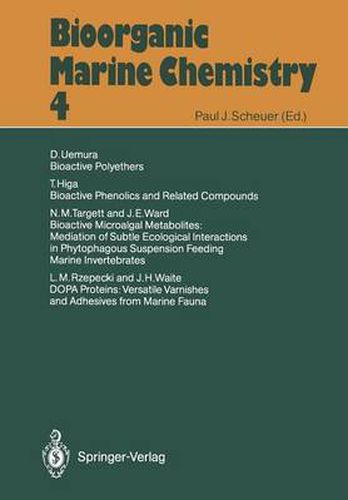Readings Newsletter
Become a Readings Member to make your shopping experience even easier.
Sign in or sign up for free!
You’re not far away from qualifying for FREE standard shipping within Australia
You’ve qualified for FREE standard shipping within Australia
The cart is loading…






This title is printed to order. This book may have been self-published. If so, we cannot guarantee the quality of the content. In the main most books will have gone through the editing process however some may not. We therefore suggest that you be aware of this before ordering this book. If in doubt check either the author or publisher’s details as we are unable to accept any returns unless they are faulty. Please contact us if you have any questions.
The contributions in this Volume, the fourth in the series Bioorganic Marine Chemistry, encompass topics which are of current concern and highlight the on-going evolution in this area of research. The growing importance of long-chain polyethers with their remarkable biological properties could not be foreseen in 1981, when the first marine representative of this class of compounds, okadaic acid, was described. Since then, the Gulf to Mexico red tide agents, the brevetoxins, and a ciguatera-causing compound, ciguatoxin, among others, have been structurally defined. Uemura, who has been prominently involved in this research, provides an authoritative treatment of known polyethers of marine origin. Worldwide em- phasis on the biological activity of natural products is also reflected in Higa’s contribution, which focusses on the phenolic character of organic secondary metabolites from a broad spectrum of marine biota. In a field which heavily depends on interaction with biology we tend to emphasize a phyletic orientation and are apt to overlook the unifying character which the functional group imparts to organic chemistry. Higa’s chapter is a timely reminder that we should not lose sight of fundamental organic chemical principles. Polyethers, discussed in Chapter 1, illustrate yet another facet of bioorganic marine chemistry. Okadaic acid, first isolated from two genera of sponges with habitats in two oceans, was subsequently recognized as a metabolite of a marine microalga, the dinoflagellate Prorocentrum lima.
$9.00 standard shipping within Australia
FREE standard shipping within Australia for orders over $100.00
Express & International shipping calculated at checkout
This title is printed to order. This book may have been self-published. If so, we cannot guarantee the quality of the content. In the main most books will have gone through the editing process however some may not. We therefore suggest that you be aware of this before ordering this book. If in doubt check either the author or publisher’s details as we are unable to accept any returns unless they are faulty. Please contact us if you have any questions.
The contributions in this Volume, the fourth in the series Bioorganic Marine Chemistry, encompass topics which are of current concern and highlight the on-going evolution in this area of research. The growing importance of long-chain polyethers with their remarkable biological properties could not be foreseen in 1981, when the first marine representative of this class of compounds, okadaic acid, was described. Since then, the Gulf to Mexico red tide agents, the brevetoxins, and a ciguatera-causing compound, ciguatoxin, among others, have been structurally defined. Uemura, who has been prominently involved in this research, provides an authoritative treatment of known polyethers of marine origin. Worldwide em- phasis on the biological activity of natural products is also reflected in Higa’s contribution, which focusses on the phenolic character of organic secondary metabolites from a broad spectrum of marine biota. In a field which heavily depends on interaction with biology we tend to emphasize a phyletic orientation and are apt to overlook the unifying character which the functional group imparts to organic chemistry. Higa’s chapter is a timely reminder that we should not lose sight of fundamental organic chemical principles. Polyethers, discussed in Chapter 1, illustrate yet another facet of bioorganic marine chemistry. Okadaic acid, first isolated from two genera of sponges with habitats in two oceans, was subsequently recognized as a metabolite of a marine microalga, the dinoflagellate Prorocentrum lima.